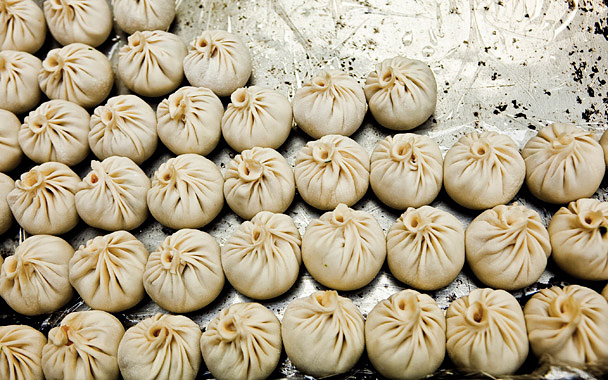Even before I’ve stepped off the plane in Los Angeles, my mom has texted me: “Where do you want to eat?” She’s been asking me this for months, ever since I booked my ticket home to Monterey Park, the “first suburban Chinatown” in America and the gateway to the string of suburban Chinatowns that stretches along the San Gabriel Valley.
Although a mere ten miles east of downtown Los Angeles, Monterey Park was a world apart when I was a kid. Tumbleweeds rolled down our street from the scrub-covered hills above our house; Marie Callendar’s was the best restaurant in town. I remember the city council meetings where my dad argued for his American dream—developing a strip mall complete with dim sum palace, Chinese bakery, and shaved-ice shop—and how the city’s old guard fought it hard. (The restaurant was lovely; it closed soon after it opened. “We were way ahead of our time,” my dad sighs.) But eventually the floodgates opened and hungry immigrants poured in. Now there are an astounding number of Chinese restaurants from Monterey Park to Rowland Heights, another 30 miles east and south past the Orange County border. New restaurants open every day, competing furiously to deliver the most authentic and delicious dishes at the lowest possible price, and the best chefs move from kitchen to kitchen like free-agent athletes. In other words, I don’t know, Mom—I can’t know—where I want to eat until I start eating. Any place will be pretty good, but why settle for that? Here, I can have what is easily the best Chinese food in America.
My first stop is for breakfast at Yi Mei Pastries, a Taiwanese hole-in-the-wall virtually unchanged since it opened 30 years ago. I get steamed pork and cabbage buns; a braised-beef sandwich with pickled greens; flaky scallion pastries; and savory crullers two ways: one for dipping into hot, sweet soy milk; one wrapped like sushi in sweet rice. Everyone I know loves this place, but it’s managed to stay under the radar. Maybe it’s because they didn’t print a menu in English until last year.
Or maybe it’s because most people think dim sum when they think Chinese breakfast. Among the seemingly numberless dim sum options in the San Gabriel Valley, Elite Restaurant is a cut above. It offers all the familiar dishes—barbecued pork buns, sticky rice in lotus leaves, steamed spareribs with black beans and chile—but chef Peter Lai adds novel twists or simply does the standard versions better. Take the fried tofu—the silken center holds just until it hits your tongue before melting and releasing a flood of delicate flavors. Like so many dishes at Elite, those flavors originate in the traditional stocks and sauces that are the very soul of Cantonese haute cuisine. When I ask my parents why they don’t come here all the time, they respond, “It’s so much more expensive than the other places.” The bill for our table of five? Thirty-five dollars.
True, that doesn’t beat the $4.95 lunch special at Monterey Palace, a Cantonese standby renowned for its crisp-skinned suckling pig and soy-sauce chicken. (The restaurant opened as an extension of the owners’ live poultry store, and the soy-sauce chicken is made from birds raised specifically for this dish.) This is also the place to go if you’ve ever wondered what exactly wok hay (the “breath of the wok”) is. That nuanced seared-steamed quality shines through in all the stir-fries, particularly in the clams with black beans and the shrimp with eggplant.
As with almost every other restaurant in the San Gabriel Valley, you shouldn’t judge Duck House by its gimmicky name or by the tacky Christmas lights in the windows. I love their nontraditional Peking duck, served with warm crÍpes for wrapping the crackling skin, tender meat, and tangle of julienned cucumbers and scallions. Some undoubtedly junior cook scrapes the excess fat from each amber shard of skin, leaving a thin, level layer that bursts with juiciness without even the slightest hint of grease. The duck’s roasted bones are simmered into an exquisite milky broth. Duck House, indeed.
Our parents and grandparents have come so far from the lean years of World War II and the Cultural Revolution that followed, and they now enjoy meaty feasts on the other side of the world. But even the meatless meals are amply rewarding. Outside Happy Family, a vegetarian restaurant, a sign warns, “Please don’t bring any food containing meat into this establishment.” I then proceed to order smoked bean curd “fish” and soy-braised wheat gluten “goose.” These bear a striking resemblance to the real thing and taste vastly better than they sound. Still, it’s the unabashed vegetable dishes like the stir-fried spinach and the mung-bean noodles with mustard greens and edamame that make me consider converting.
But these places are old favorites, and I want to taste what’s new. So I follow our longtime neighbors to their favorite restaurant, Chuen Hing, a hard-to-find, bare-bones Chiu Chow place. We start with crisp boiled green beans coated in a fried ginger sauce that’s mellow and creamy yet bright, a mystery of heat and spice. I beg the chef for the recipe. Slouched in a tattered flannel shirt, he could easily be mistaken for the dishwasher, but there’s no mistaking the offense he takes at my impudence. “I can’t give you the recipe! It’s my secret!” So I don’t bother to ask about the lacquered pork belly in steamed kabocha squash or the braised-beef-brisket soup noodles or the bitter-melon omelet. I simply savor every bite.



 Pinterest
Pinterest






